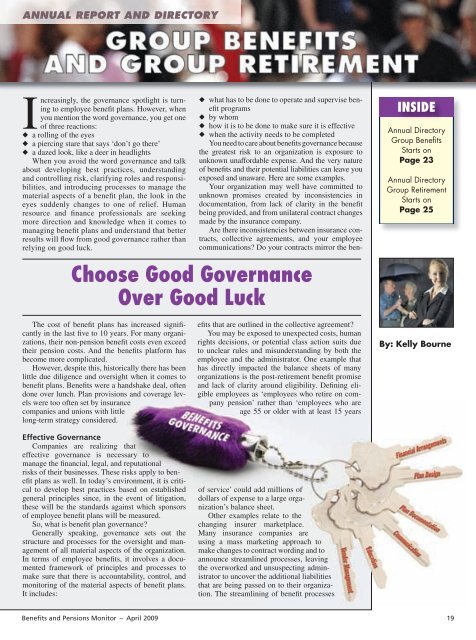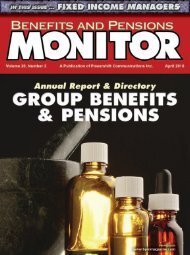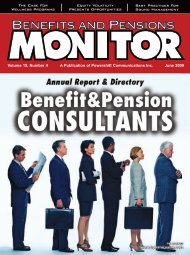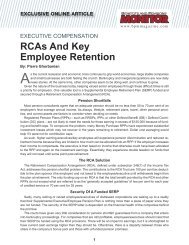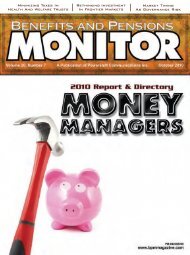April - Benefits and Pensions Monitor
April - Benefits and Pensions Monitor
April - Benefits and Pensions Monitor
You also want an ePaper? Increase the reach of your titles
YUMPU automatically turns print PDFs into web optimized ePapers that Google loves.
ANNUAL REPORT AND DIRECTORY<br />
Increasingly, the governance spotlight is turning<br />
to employee benefit plans. However, when<br />
you mention the word governance, you get one<br />
of three reactions:<br />
◆ a rolling of the eyes<br />
◆ a piercing stare that says ‘don’t go there’<br />
◆ a dazed look, like a deer in headlights<br />
When you avoid the word governance <strong>and</strong> talk<br />
about developing best practices, underst<strong>and</strong>ing<br />
<strong>and</strong> controlling risk, clarifying roles <strong>and</strong> responsibilities,<br />
<strong>and</strong> introducing processes to manage the<br />
material aspects of a benefit plan, the look in the<br />
eyes suddenly changes to one of relief. Human<br />
resource <strong>and</strong> finance professionals are seeking<br />
more direction <strong>and</strong> knowledge when it comes to<br />
managing benefit plans <strong>and</strong> underst<strong>and</strong> that better<br />
results will flow from good governance rather than<br />
relying on good luck.<br />
◆ what has to be done to operate <strong>and</strong> supervise benefit<br />
programs<br />
◆ by whom<br />
◆ how it is to be done to make sure it is effective<br />
◆ when the activity needs to be completed<br />
You need to care about benefits governance because<br />
the greatest risk to an organization is exposure to<br />
unknown unaffordable expense. And the very nature<br />
of benefits <strong>and</strong> their potential liabilities can leave you<br />
exposed <strong>and</strong> unaware. Here are some examples.<br />
Your organization may well have committed to<br />
unknown promises created by inconsistencies in<br />
documentation, from lack of clarity in the benefit<br />
being provided, <strong>and</strong> from unilateral contract changes<br />
made by the insurance company.<br />
Are there inconsistencies between insurance contracts,<br />
collective agreements, <strong>and</strong> your employee<br />
communications? Do your contracts mirror the ben-<br />
Choose Good Governance<br />
Over Good Luck<br />
INSIDE<br />
Annual Directory<br />
Group <strong>Benefits</strong><br />
Starts on<br />
Page 23<br />
Annual Directory<br />
Group Retirement<br />
Starts on<br />
Page 25<br />
The cost of benefit plans has increased significantly<br />
in the last five to 10 years. For many organizations,<br />
their non-pension benefit costs even exceed<br />
their pension costs. And the benefits platform has<br />
become more complicated.<br />
However, despite this, historically there has been<br />
little due diligence <strong>and</strong> oversight when it comes to<br />
benefit plans. <strong>Benefits</strong> were a h<strong>and</strong>shake deal, often<br />
done over lunch. Plan provisions <strong>and</strong> coverage levels<br />
were too often set by insurance<br />
companies <strong>and</strong> unions with little<br />
long-term strategy considered.<br />
Effective Governance<br />
Companies are realizing that<br />
effective governance is necessary to<br />
manage the financial, legal, <strong>and</strong> reputational<br />
risks of their businesses. These risks apply to benefit<br />
plans as well. In today’s environment, it is critical<br />
to develop best practices based on established<br />
general principles since, in the event of litigation,<br />
these will be the st<strong>and</strong>ards against which sponsors<br />
of employee benefit plans will be measured.<br />
So, what is benefit plan governance?<br />
Generally speaking, governance sets out the<br />
structure <strong>and</strong> processes for the oversight <strong>and</strong> management<br />
of all material aspects of the organization.<br />
In terms of employee benefits, it involves a documented<br />
framework of principles <strong>and</strong> processes to<br />
make sure that there is accountability, control, <strong>and</strong><br />
monitoring of the material aspects of benefit plans.<br />
It includes:<br />
efits that are outlined in the collective agreement?<br />
You may be exposed to unexpected costs, human<br />
rights decisions, or potential class action suits due<br />
to unclear rules <strong>and</strong> misunderst<strong>and</strong>ing by both the<br />
employee <strong>and</strong> the administrator. One example that<br />
has directly impacted the balance sheets of many<br />
organizations is the post-retirement benefit promise<br />
<strong>and</strong> lack of clarity around eligibility. Defining eligible<br />
employees as ‘employees who retire on company<br />
pension’ rather than ‘employees who are<br />
age 55 or older with at least 15 years<br />
of service’ could add millions of<br />
dollars of expense to a large organization’s<br />
balance sheet.<br />
Other examples relate to the<br />
changing insurer marketplace.<br />
Many insurance companies are<br />
using a mass marketing approach to<br />
make changes to contract wording <strong>and</strong> to<br />
announce streamlined processes, leaving<br />
the overworked <strong>and</strong> unsuspecting administrator<br />
to uncover the additional liabilities<br />
that are being passed on to their organization.<br />
The streamlining of benefit processes<br />
By: Kelly Bourne<br />
<strong>Benefits</strong> <strong>and</strong> <strong>Pensions</strong> <strong>Monitor</strong> – <strong>April</strong> 2009<br />
19


